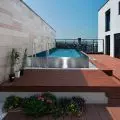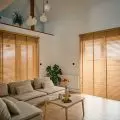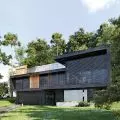A clever combination of two well-known types of wood construction makes the most of the advantages of one of the oldest building materials in the world. LVL laminated veneer performs perfectly in demanding structures, facilitates the design of nodes and the transfer of heavy loads. With LVL, it is possible to reduce the use of steel components. In addition, LVL has a visually appealing surface with a "Fineline-Optik" structure, which gives a unique character to the interior of the new STEICO office building.
expansion axonometry
© STEICO
The expansion of STEICO's headquarters in Feldkirchen near Munich creates additional workspace with 2120 m² of usable and office space, which is necessary for the company's continued growth. The new 4-story building in building class 5 (width approx. 13 m, length approx. 46 m) houses parking spaces, training and storage areas on the covered first floor. The next three floors contain offices, a canteen with a loggia, as well as a fitness room. The new building is harmoniously connected to the existing office building through a glass walkway. It was extremely important to create an optimal working environment with a prominent wooden structure and plenty of daylight and good air conditioning. The three office floors were designed as a pure wood structure, using STEICO's own laminated veneer (LVL) system, I-beams and wood fiber thermal insulation materials.
A simple laminated veneer frame structure combined with non-load-bearing wall panels is central to the building concept. The load-bearing structure of the exterior walls is shifted inward and consistently "stripped" from the facade elements, analogous to classic reinforced concrete frame construction. This method avoids thermal bridges caused by the presence of massive load-bearing elements in the thermal insulation layer. Vertical loads are safely carried by floor elements, beams and columns made of strong LVL glued beams and by interior walls made of cross-laminated timber. Using only one load-bearing interior wall and floor and roof elements with spans of up to 7.25 meters, a highly flexible room layout with non-load-bearing interior walls can be realized.
© STEICO
The fire resistance of the floor and roof structures, columns and joists was rated at 90 minutes (F90-B) - calculations based on the degree of charring. External prefabricated walls are made of I-beams and laminated veneer. The thickness of the wall (the structure itself) is 360 mm. On the outside, the walls were sealed with STEICOprotect H wood fiber thermal insulation panels and a plastering system. The voids between the wall posts were filled with STEICOzell wood fiber blown-in thermal insulation. Tests carried out by the STEICO SE technical department confirm that the products used comply with DIN 4102 part 20 (fire resistance of facades) and thus make it possible to dispense with an additional fire collar in the passages between floors.
The required degree of fire resistance can be achieved through additional measures, such as the use of gypsum-fiber boards directly under STEICOprotect H facade panels. The floor and roof structure is made of visible laminated veneer elements. The roof on the outside has been thermally insulated with wood fiber boards and a layer of gravel. With U-values of 0.09 and 0.12 W/(m²*K), respectively, the structures of the exterior walls and roof correspond to the level of highly insulated passive buildings of the future.
© Steico
The individual floor/roof elements are connected from above using flat steel connectors. Such a connection allows shear forces to be transferred evenly - the elements form a disk when connected. The displacement of the floor elements in width is leveled. The elements on the underside are connected to each other using slats made of STEICOLVL X. The slats are set into grooves, cut into the floor/roof panels. The grooves are located slightly deeper, so that elegant joints are created between the elements. At the same time, the connection strips prevent looking deeper - into the higher connection zones of the elements. The width of the element 61.5 cm is selected so that an even joint structure - a regular modular grid - is formed indoors. Proper fire resistance from the inside (EI) at the junction of the elements provided by the floor structure.
Roof and ceiling elements made of STEICOGLVL R laminated veneer make the room bright and pleasant. The so-called "Fineline-Optik" structure on the inside of the elements and in the exposed areas of the beams and columns gives the lightened rooms a special aesthetic. Thanks to the visible structural elements, the user can recognize the load-bearing structure - the clear structure of the building becomes visible immediately upon entering the room. In the area of the ceilings, elements with a height of 24 cm and a length of almost 12 m were used as double-span girders with a span of up to 7.25 m. The material used has an elastic modulus of E0,mean = 14,000 N/mm² and a flexural strength of fm,0,edge,k = 44.0 N/mm². The very high load-bearing capacity makes it possible to make an elegant yet optimal design. The floor on the floor elements was made of bonded lime ballast, wood fiber sound insulation board and screed with floor heating system.
© STEICO
The new STEICO building impressively demonstrates the advantages and performance of LVL timber frame construction combined with effectively insulated prefabricated wall panels, built from lightweight, stable I-beams. The limit of the system's capabilities has not yet been reached for a building project of this size; the materials used have the potential for much larger structures.
Axel LUZ
Master carpenter and timber construction engineer, STEICO SE
For more information, visit STEICO 's A&B website.


































